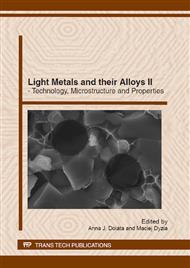p.57
p.67
p.75
p.81
p.89
p.101
p.109
p.115
p.123
Course of Solidification Process of AlMMC – Comparison of Computer Simulations and Experimental Casting
Abstract:
The aim of the paper is to present the possibilities of computational simulations for the casting of aluminum matrix composite (AlMMC) reinforced with ceramics based on experimental data. The comparison of simulation and experimental results concerned the solidification process i.e. the course of solidification, temperature distribution and final arrangement of reinforcement particles. First, we have performed the experimental gravity casting of the aluminum matrix alloy AK12 (AlSi12CuNiMg2) and the composites AK12/SiC and AK12/Cg reinforced with silicon carbide SiC and glass carbon Cg, respectively, into the sand mold. During the experiment we have recorded the temperature using the ThermaCAM photometer system as well as in the selected point inside the sand mold. Using experimental data we have carried out the numerical calculations according to the methods and procedures contained in the program ANSYS Fluent 13. We have based the simulations on the two-dimensional model in which the Volume of Fluid (VOF) and enthalpy methods have been applied. The former is to describe two-phase system (air-composite matrix free surface, volume fraction of particular continuous phase) and the latter shows modeling of the solidification process of the alloy and composite matrix. We have used the Discrete Phase Model (DPM) to depict the presence of reinforcement particles. The assumption of the appropriate values of simulation parameters has shown that the simulation results are convergent with experimental ones. We have observed a similar course of the composite solidification (temperature change at the designated point), the temperature distribution and the arrangement of reinforcement particles for the simulation and experiment.
Info:
Periodical:
Pages:
89-98
Citation:
Online since:
August 2012
Authors:
Keywords:
Price:
Сopyright:
© 2012 Trans Tech Publications Ltd. All Rights Reserved
Share:
Citation:


